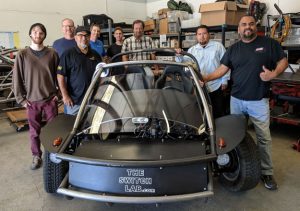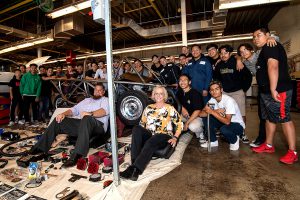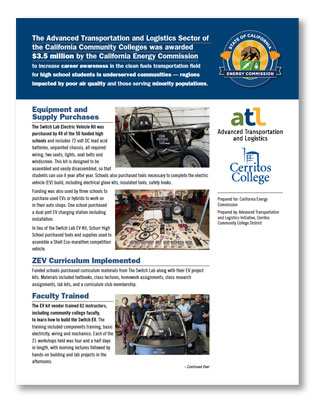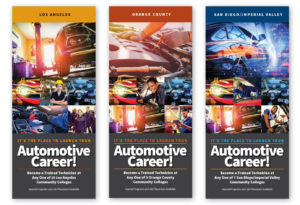
 Communities throughout California are suffering from poor air quality and a lack of resources to do something about it. A new partnership between high schools, community colleges, and the California Energy Commission aims to change that.
Communities throughout California are suffering from poor air quality and a lack of resources to do something about it. A new partnership between high schools, community colleges, and the California Energy Commission aims to change that.
The Cerritos Community College District’s Advanced Transportation Technology and Energy Center was awarded $1 million to increase career awareness in the clean fuels transportation field for high school students in underserved communities — regions impacted by poor air quality and those serving minority populations.
Ten high schools are currently participating in the project. Those confirmed thus far are:
- Adelanto High School (Inland Empire/Desert)
- Artesia High School (Los Angeles)
- Clovis West High School (Central Valley)
- Davis Senior High School (Greater Sacramento)
- Fremont High School (Bay Area)
- Mark Keppel High School (Los Angeles)
- Mira Mesa High School (San Diego)
- Schurr High School (Los Angeles)
- Valley High School (Orange County)
- Victor Valley High School (Inland Empire/Desert)
Funded high school programs will offer clean fuels technology training to students, introduce opportunities to students who may not have considered a career in clean fuels transportation, and encourage interested students to matriculate into well-established community college programs to continue their studies.
 New Equipment, Curriculum and Professional Development
New Equipment, Curriculum and Professional Development
Each high school will receive funding to purchase a Switch electric vehicle kit, which comes with curriculum for teachers to use in their classrooms. High school teachers are also paired with community college instructors from nearby schools who will serve as partners throughout the process.
High school teachers and community college instructors have attended comprehensive train-the-trainer workshops to receive the instruction they need to help their students through the assembly process. American River College and Saddleback College served as host locations for two of the four-day workshops. Sessions were divided into morning lectures and hands-on time building the Switch vehicles in the afternoon.
The vehicle used in the workshop is the same model that students will work on, and the curriculum that the instructors learn is designed to be passed along to students. Marty Supple from Artesia High School attended the training at Saddleback College and found the process easy to follow and the results were well worth the time spent building the vehicle.
“It’s a phenomenal piece of equipment; I love driving it,” Supple said. “Every high school or community college in California or elsewhere should buy one of these vehicles.”
Switch vehicle kits are designed to be a pathway into electric and renewable energy for teachers who are used to working on traditional vehicles. The company is based in Sebastopol and works with schools across the U.S.
Teachers who were initially hesitant about building electric vehicles end up becoming advocates for the technology and the Switch training process.
“We realized that teachers like to teach what they’ve been taught,” said Switch co-founder Peter Oliver.
 Energy Commission Support
Energy Commission Support
Through this project, and the recently completed Community College Alternative Fuel and Vehicle Technology Training Enhancement Program the Advanced Transportation and Logistics (ATL) Sector of the California Community Colleges will continue its work to grow and strengthen clean fuel transportation programs that prepare new workers for careers in this field, and train incumbents on the latest technologies.
“The Energy Commission’s support of these programs makes it possible for us to increase our reach across the state,” said Jannet Malig, ATL Statewide Director. “The high school students we bring into our clean fuels transportation pathways will be well prepared for jobs in this growing field.”
In October, California Energy Commissioner Janea A. Scott and staff, along with Malig, visited four of the funded Southern California high schools to meet students who will soon be building their school’s new Switch Electric Vehicle. Each visit included a facility tour and presentations by teachers, students, and administrators to showcase achievements inside and outside of the classroom.
“I am inspired by the leadership the students are showing, the creativity and innovation,” Scott said. “Everything the students are learning in this space will guide us into the future of cleaner transportation. We can’t do it without the students’ engagement and enthusiasm, or the educators who are providing students with this meaningful, hands on experience.”
The team visited Mira Mesa High School in San Diego, which serves nearly 2,500 students. More than half of its student body is eligible for free or reduced-price lunches, and nearly 10 percent have a disability.
The school has already received its Switch electric vehicle and had all of the parts unpacked and ready for painting during the Energy Commission visit. But what made this visit unique, is that the students didn’t know about it in advance.
After a tour of the campus and CTE programs, instructor Ryan Monroe and district colleagues introduced the Energy Commission visitors to the class and announced to the students that Mira Mesa was the only high school chosen in the San Diego area to receive this grant. Monroe explained that they would be learning about electric vehicles by building the Switch Lab car.
Monroe also teaches at San Diego Miramar College, and is hopeful that Mira Mesa students will funnel into the college program after graduating.
The automotive field, particularly hybrid and alternative fuel vehicles, provides stable, high-paying jobs to students from a variety of backgrounds. Because of this funding and the dedication of instructors, administrators and other partners, the schools are creating pathways from high school to community college to the workforce.
“California is transitioning to low-carbon fuels and zero- and near zero- emission transportation in order to meet its ambitious climate change goals and federal air quality standards. Ensuring a well-trained workforce to develop, deploy, and shepherd this transition is critical,” said Scott.



